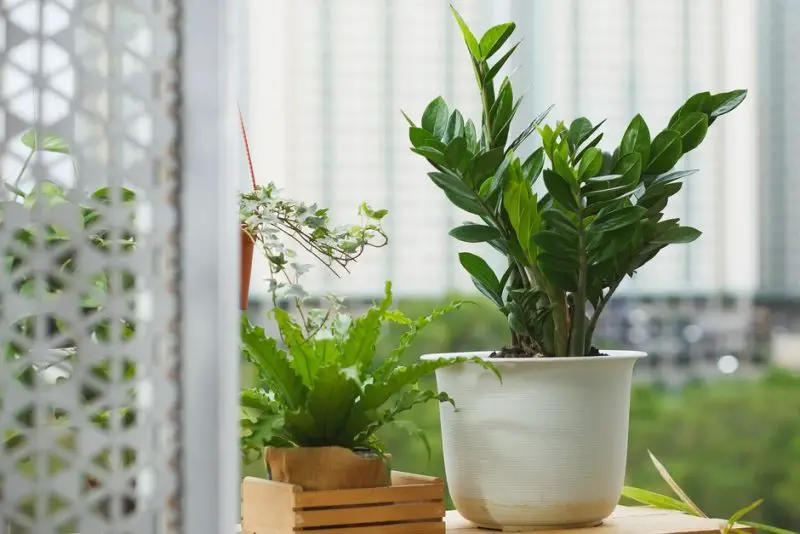The ZZ plant has become one of the most popular indoor plants because it thrives with very little care. Many beginners choose it because the plant tolerates low light, irregular watering, and a wide range of conditions. Its thick rhizomes store moisture and help the plant survive stressful periods without losing strength. This unique structure makes it ideal for people who want a beautiful plant that grows slowly and steadily. The glossy leaves reflect light and brighten any corner of a room. With the right guidance, even new growers can help the ZZ plant reach its full potential and maintain a strong appearance.
This article provides a clear and practical guide that helps beginners understand how to grow a ZZ plant successfully. Each section explains essential elements that support stable growth and long-term health. The plant adapts easily when environmental factors stay consistent and predictable. You will learn how light, water, soil, and temperature shape the plant’s rhythm. You will also discover how to avoid common issues that weaken growth. This guide focuses on real conditions that match the plant’s natural biology. When you follow these steps, your ZZ plant will grow stronger, healthier, and more resilient over time.
Understanding the Natural Growth Pattern of the ZZ Plant

The ZZ plant follows a slow and steady growth rhythm that depends heavily on environmental stability. Its thick rhizomes act as storage organs that hold water and nutrients for long periods. These structures protect the plant during dry cycles or inconsistent care. Many beginners worry when growth seems slow, but slow growth is normal for this species. It prefers to expand gradually and only invests energy into new stems when conditions remain consistent. When the plant receives balanced care, its leaves become glossy and firm, showing strong internal health.
You should pay attention to how the plant reacts to different levels of light and watering. The ZZ plant adapts well to mild shifts because its rhizomes regulate internal moisture. However, large environmental changes interrupt its natural rhythm. This interruption slows its development and delays new shoots. The plant responds best when soil moisture stays even and light remains predictable. New stems appear from the base and grow upward in a smooth and steady pattern. These stems start short but strengthen as the plant channels energy into structural formation.
The ZZ plant evolved in dry forest floors where light is filtered and moisture remains limited. Its leaves are designed to reflect available light and reduce water loss. This adaptation allows the plant to survive in low-maintenance conditions indoors. You should create an environment that matches these natural origins. Avoid overwatering and keep lighting moderate to maintain biological balance. When the plant receives stable care, it builds resilience and develops a reliable growth cycle. Understanding these natural patterns helps beginners support long-term health and encourages fresh growth with confidence.
Choosing the Right Soil Mix for Strong and Balanced Growth
The soil mix you choose has a major impact on how well a ZZ plant develops over time. This plant needs a medium that drains quickly while still holding enough moisture to support slow and steady growth. Its rhizomes store large amounts of water, so heavy soil traps too much moisture and restricts airflow. You should choose a mix that feels light and crumbly when handled. A well-balanced combination encourages root expansion and prevents rot. When the soil allows air movement, the plant builds strong internal structure and maintains its natural rhythm.
You should avoid dense garden soil because it compacts easily and suffocates the rhizomes. Compacted soil slows nutrient movement and traps excess water around the base. A porous mix supports the plant’s natural cycle and helps regulate moisture evenly. Many growers prefer using a blend that includes perlite or coarse sand. These ingredients increase airflow and lighten the texture. A small amount of organic matter keeps the mix nutritious without making it heavy. When the soil drains well, the plant remains stable even during irregular watering. Consistent drainage is essential for long-term strength.
Before potting the plant, you should prepare the soil so it maintains balanced moisture from the beginning. Lightly moisten the mix to create a stable base that supports the rhizomes. Dry soil absorbs water from the roots and weakens the plant during early development. A slightly damp mix protects the plant and helps it settle into its new container. When you place the plant in the pot, avoid pressing the soil too firmly. Gentle pressure keeps the structure loose and allows healthy airflow. A proper soil mix forms the foundation for strong and predictable growth.
Providing the Ideal Light Conditions for Healthy ZZ Plant Growth
The ZZ plant responds strongly to lighting because light controls its growth speed and leaf quality. This plant evolved in shaded woodlands where sunlight filters through layers of foliage. As a result, it thrives in indirect light rather than strong direct sun. When the plant receives gentle light, its leaves remain glossy and vibrant. Direct sun burns the leaf surface and creates pale or brown patches. You should place the plant where brightness feels soft and diffused. This condition supports steady photosynthesis without stressing the foliage or the rhizomes.
You should observe the plant’s reaction to its current lighting environment. If the stems stretch toward the light, the plant may need a brighter location. Stretched stems weaken the plant’s structure and slow its natural rhythm. If the leaves turn yellow or develop dry edges, the light may be too intense. You should adjust the plant gradually to avoid shock. Even small changes in lighting can influence the plant’s internal balance. A stable and predictable light source helps the ZZ plant maintain healthy growth patterns. Its slow nature makes consistent lighting even more important.
Artificial lighting can also support the ZZ plant when natural light is limited. A soft grow light placed at a safe distance provides balanced brightness without heat stress. You should run the light for several hours each day to mimic natural patterns. This routine supports steady energy production and prevents weak stems. When using artificial light, ensure the plant does not sit too close because heat can damage foliage. A controlled lighting schedule keeps the plant strong and encourages new shoots. Ideal lighting protects the plant from stress and strengthens its long-term development.
Watering Techniques That Match the ZZ Plant’s Natural Rhythm
Watering plays a major role in how well a ZZ plant grows because the plant stores moisture inside its thick rhizomes. These rhizomes hold enough water to support the plant during long dry periods. You should allow the soil to dry partially before watering again. Constant moisture slows the plant’s natural rhythm and weakens its structure. When the soil dries slightly, the roots receive fresh oxygen and stay healthy. Overwatering suffocates the rhizomes and leads to yellow leaves. A controlled watering routine protects the plant and matches its biological design.
You should check soil moisture by touching the upper layer. If it feels dry, water the plant slowly until excess drains from the bottom. Fast watering creates uneven pockets that stress the roots. Slow watering keeps the soil texture balanced and prevents saturation. The plant absorbs moisture gradually and uses it efficiently. You should avoid watering on a strict schedule because the plant’s needs change with seasons. Warm months increase evaporation, while cooler months slow the plant’s activity. Flexible watering supports steady growth throughout the year.
You should always use room-temperature water because cold water shocks the roots. Warm water encourages smooth nutrient movement and stable internal processes. After watering, you should remove any standing water from the saucer. Trapped water increases humidity around the roots and causes early decay. If the plant shows wrinkled stems, it may need deeper hydration. When the leaves feel firm and glossy, the balance is correct. Consistent and mindful watering strengthens the plant’s resilience and keeps its growth slow but reliable. Proper moisture management is one of the most important steps for a healthy ZZ plant.
Creating the Right Temperature and Humidity for Steady ZZ Plant Growth
The ZZ plant grows best in stable indoor temperatures that remain within a comfortable and predictable range. It prefers gentle warmth because its native regions maintain steady conditions throughout the year. You should keep the plant in temperatures that avoid sudden shifts. Sharp drops slow metabolic activity and weaken new stems. Excess heat also stresses the leaves and accelerates moisture loss. When temperatures remain even, the plant maintains strong internal balance. This stability allows the ZZ plant to grow steadily and preserve firm, glossy foliage that indicates good health.
Humidity also plays an important role in the plant’s ability to regulate moisture. Although the ZZ plant tolerates dry air better than many tropical species, moderate humidity supports smoother internal processes. Extremely dry rooms cause leaf edges to lose moisture and disrupt the plant’s natural rhythm. You should keep the plant away from heaters, vents, and drafty windows. These areas create inconsistent humidity and temperature changes. Gentle airflow in a stable room helps the plant stay balanced. A predictable environment allows the ZZ plant to channel energy into long-term development rather than stress management.
You should observe the leaves carefully to understand how the plant responds to its surroundings. Curling edges often signal dryness, while soft or limp leaves point to temperature stress. When the plant receives steady conditions, the leaves stay vibrant and firm. This response shows that the plant is managing moisture effectively. You can raise humidity slightly by grouping plants together or placing a small water tray nearby. Avoid misting the leaves because it adds unnecessary surface moisture. A careful combination of stable temperature and balanced humidity supports predictable growth and strengthens the plant’s resilience.
Choosing the Right Pot and Repotting at the Proper Time
Selecting the correct pot is essential for supporting the ZZ plant’s slow and steady growth. This plant prefers containers that offer good drainage because its rhizomes store large amounts of moisture. A pot with several drainage holes prevents water from sitting around the roots. Excess water leads to rot and disrupts the plant’s internal balance. You should choose a pot that is only slightly larger than the current one. A pot that is too big holds moisture longer than the plant can manage. When the pot size matches the root system, the plant remains stable and develops at a healthy pace.
Repotting should happen only when the plant shows clear signs of being root-bound. Thick rhizomes may begin pressing against the pot walls or lifting the soil surface. These signs show that the plant needs more room to expand. You should remove the plant gently and check the root system before repotting. If the roots appear firm and healthy, place the plant in a new pot with fresh soil. A loose and airy mix supports immediate adjustment and prevents stress. Avoid repotting during cold seasons because low temperatures slow recovery. Warm months help the plant settle faster.
You should monitor the plant closely after repotting to ensure proper adaptation. Slight wilting can occur because the rhizomes adjust to new soil conditions. This reaction is normal and fades when the environment stays consistent. Provide indirect light and balanced moisture to support early recovery. Do not fertilize immediately because new roots are sensitive. Allow the plant to stabilize before restarting normal care. When the leaves become firm again, the plant has adapted well. A well-timed repotting routine maintains the plant’s growth rhythm and supports long-term strength.
Understanding Fertilization Needs for Strong and Healthy Growth
Fertilizing a ZZ plant requires a gentle and controlled approach because this species grows slowly and stores nutrients in its rhizomes. Heavy feeding overwhelms the plant and disrupts its natural rhythm. You should use a mild liquid fertilizer that supports balanced growth without stressing the roots. A diluted formula provides steady nutrition and encourages healthy leaf color. The plant absorbs nutrients slowly, so consistency matters more than intensity. When fertilizer remains gentle, the ZZ plant builds strength at a stable pace and maintains firm, glossy foliage throughout the year.
You should fertilize only during the warmer months when the plant is naturally more active. Cooler seasons slow metabolic processes, and nutrients may sit unused in the soil. This causes salt buildup and can damage the roots. You should apply fertilizer once every few weeks to support gradual development. If the plant grows in low light, reduce feeding because low light slows nutrient use. Observing the plant’s response helps you find the ideal rhythm. Deep green leaves indicate proper feeding, while pale foliage suggests the plant needs slightly more support.
You should avoid using strong fertilizers formulated for fast-growing plants. These blends release nutrients too quickly and can burn delicate root tissues. You should also ensure the soil drains well so fertilizer moves through the mix without pooling. After feeding, water lightly to distribute nutrients evenly. Do not fertilize a plant that was recently repotted because young roots are sensitive. Give the plant time to stabilize before adding nutrients. When fertilization matches the plant’s natural pace, the ZZ plant produces steady growth and long-lasting vigor. A careful approach ensures healthy development and resilience over time.
Recognizing Early Signs of Stress and How to Respond Correctly
The ZZ plant is known for its resilience, but it still shows subtle signs when something in its environment is unbalanced. You should observe the leaves carefully because they reveal early stress signals. Yellowing leaves often indicate overwatering, while brown edges usually point to dry air or excessive light. Soft stems suggest root issues caused by poor drainage or soil saturation. When you notice these changes early, you can adjust care before the plant’s health declines further. The ZZ plant responds slowly, so stress signs appear gradually. This slow response allows time for corrective actions that restore balance.
You should also pay attention to how the plant behaves during seasonal changes. Cooler months slow growth, and the plant may reduce water use naturally. If you maintain warm-season watering during winter, the rhizomes may become oversaturated. Adjusting your routine to match seasonal rhythms protects the plant from unnecessary stress. You should also avoid moving the plant too frequently because environmental shifts disrupt its internal balance. A stable position with predictable light and temperature helps the plant regain strength. Gentle care supports smoother recovery and healthier long-term development.
When correcting stress, you should make changes slowly to avoid further disruption. If the plant receives too much light, move it slightly away rather than placing it in deep shade. If soil feels heavy and wet, allow it to dry more thoroughly before watering again. When humidity is too low, improve moisture gradually with nearby water trays. These small adjustments help the plant recover without shock. As the environment stabilizes, the leaves regain their glossy appearance. Recognizing stress early and responding calmly ensures the ZZ plant remains steady, strong, and adaptable in the long run.
Preventing Common Mistakes That Slow ZZ Plant Growth
Avoiding Watering and Lighting Mistakes
Overwatering remains the most common cause of decline in ZZ plants because the rhizomes already store large amounts of moisture. When beginners water too often, the soil becomes saturated and forces oxygen out of the root zone. Without oxygen, the roots soften and lose their ability to transport nutrients. Yellow leaves appear soon after because the plant cannot regulate moisture correctly. You should allow the top layer of soil to dry before watering again. This drying period restores balance and protects the rhizomes from decay. A predictable watering rhythm helps the plant maintain internal stability and develop at a steady pace.
Lighting mistakes also affect growth significantly because the ZZ plant evolved under filtered forest light. Strong direct sun overheats the leaves and causes burn marks that weaken their structure. Many beginners place the plant near a window with harsh exposure, hoping for faster growth. However, bright but indirect light is safer and more effective. It supports gentle photosynthesis while preventing moisture loss. Moving the plant gradually toward a brighter area allows smoother adaptation. A consistent lighting environment encourages firm stems and glossy leaves, which show that the plant is growing comfortably without stress.
Avoiding Soil and Pot Size Problems
Soil quality directly affects the ZZ plant’s ability to breathe and regulate moisture. When the soil is dense, water remains trapped around the rhizomes, creating an environment where rot develops easily. The roots struggle to expand because they cannot push through compact material. A loose mix gives the plant the space it needs to anchor itself firmly. You should choose soil that feels airy and drains immediately after watering. Perlite or coarse sand improves structure and prevents compaction. Healthy soil helps regulate nutrient absorption and supports gradual, stable growth throughout the year.
Pot size is another factor that beginners often overlook. A pot that is too large retains moisture for too long, which slows the drying cycle. This creates an imbalance that encourages fungal problems. A pot that is slightly larger than the previous one allows the soil to dry predictably and supports healthier root expansion. You should repot only when the rhizomes press against the container or distort the soil surface. Choosing a balanced pot size ensures the plant grows at its natural pace. Proper potting helps maintain strong internal structure and protects the plant from unnecessary stress.
Avoiding Fertilizer and Stress-Related Mistakes
Fertilizer misuse is a frequent issue because many beginners think strong nutrients will force faster growth. However, the ZZ plant grows slowly by nature and does not absorb large nutrient amounts quickly. Concentrated fertilizer burns the roots and changes the soil’s chemical balance. You should use diluted liquid fertilizer only during warm seasons when the plant is most active. This gentle feeding supports healthy leaf color and slow, controlled development. Allowing the plant to rest during cooler months prevents salt buildup and preserves soil quality.
Ignoring stress signals is another mistake that delays growth. The ZZ plant communicates its needs through subtle changes in leaf color and firmness. Curling or fading leaves indicate environmental imbalance, while soft stems suggest poor drainage or overwatering. You should make adjustments slowly to avoid shocking the plant. Improving airflow, modifying light levels, or adjusting watering schedules can restore balance gradually. A calm and consistent approach supports recovery and prevents long-term damage. Paying attention to early signs helps maintain stable conditions and encourages strong, resilient growth.
FAQs About Growing ZZ Plant
Why is my ZZ plant growing so slowly?
The ZZ plant naturally grows slowly because it relies on thick rhizomes that store water and nutrients. Slow growth is normal and not a sign of poor health. When light, moisture, and temperature remain stable, the plant produces new stems at a steady pace.
How often should I water a ZZ plant?
You should water only when the top layer of soil feels dry. The plant stores moisture in its rhizomes and does not need frequent watering. Allowing the soil to dry slightly prevents rot and supports healthy airflow. A flexible routine based on soil condition works best.
Can a ZZ plant survive in low light?
Yes, the ZZ plant tolerates low light better than many indoor plants. However, it grows more efficiently in bright but indirect light. Low light slows growth but does not harm the plant. Avoid direct sunlight because strong exposure burns the leaves.
Why are the leaves on my ZZ plant turning yellow?
Yellow leaves often indicate overwatering or poor soil drainage. Excess moisture suffocates the roots and disrupts nutrient flow. Allow the soil to dry more completely and check that the pot drains well. Adjust watering habits gradually to help the plant recover.
Do ZZ plants need fertilizer?
ZZ plants need only light fertilization during active growth months. A diluted liquid fertilizer every few weeks supports healthy leaves and steady development. Avoid heavy feeding or winter fertilization because nutrient buildup harms the roots and slows growth.
Conclusion
The ZZ plant grows best when its environment remains stable, predictable, and gentle. With the right balance of light, moisture, soil, and temperature, the plant develops strong rhizomes and firm, glossy leaves. Its slow pace is natural and reflects its resilient biology. When beginners understand this rhythm, they can care for the plant with confidence. Small adjustments and consistent attention support long-term strength. Over time, the ZZ plant rewards patient growers with steady, reliable growth.






